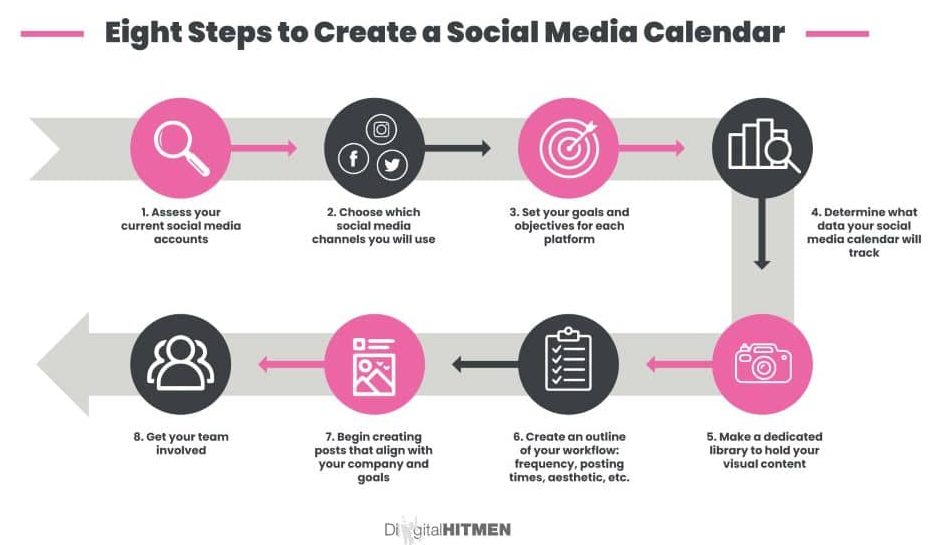Does this sound familiar to you? You have spent your busy workday trying to stay one step ahead of your competitors. You are about to call it a day when the thought occurs to you, “I haven’t made any social media posts today.” You then grab the nearest internet-connected device and toss together a generic post with little content value.
You share the off the cuff information. However, you do not feel good about your post. You know it has nothing to do with any essential facets of your business, nor does it provide your audience with any helpful information. To top it all off, many of your followers will not see it because of the late hour.
If you have similar experiences, you are not alone. Unfortunately, you are losing valuable ground to the competition. If you were not already aware, there are millions of Australians who engage in one or more types of social media every day. To grow your business, you need to connect with these people in meaningful ways, consistently.
So, how can you stay on top of social media posts and maintain your productivity in other areas of your company? The key is a well-planned social media content plan, also called a social media calendar.
In this post, you’ll learn what a social media calendar is, how to create one, what content to share, and useful tools to maximise the effectiveness of your social media campaigns.
What is a social media calendar?
A social media calendar (or social media content plan) is a tool you can use to keep track of social media posts. You can plan posts around events and not worry about forgetting to share something with your social media channels. Additionally, you can schedule your posts ahead of time to enhance consistency.
Why should I use a social media calendar?
You can think of your social media calendar as your blueprint. No one in the construction industry would dream of heading to a worksite and slapping some boards and drywall together without a plan in hand. Without the right plans, the product would be shoddy, and the potential for disaster would be looming.
Your social media calendar serves a similar purpose. You can highlight your goals and get the most out of your social media presence. More specifically, a good social media content plan offers the following benefits:
- Your posts are consistent – Regardless of the platform, regular posting is in your company’s best interest. When you appear in followers’ feeds regularly, they are more likely to engage with you. It is like seeing a familiar face in a vast sea of humanity. Once your followers recognise you, feel comfortable, and engage, the increase in engagements ups your organic reach on the social media platform. This happens because of the algorithm the platform uses. As your organic reach grows, you will find new followers whose engagement will increase your reach even more.
- Being organised saves time – This benefit of a social media calendar is something most of us have heard all of our lives. “Organisation is the key to…insert important outcome here.” In the context of social media, plan your posts, and you will not find yourself frantically looking for content remotely relevant to your company at midnight.
- Stay on top of relevant moments – Whether you are posting about Picnic Day, the Queen’s Birthday, or Boxing Day, these posts should be on time. Otherwise, you risk irrelevancy. If it is appropriate, you can also plan to add a little fun to scheduled posts. Several online resources list unique and silly holidays. Your followers may want to acknowledge world hangover day if you bring it to their attention.
- Create content with no typos – It sounds obvious that you want your content sharp and error-free. The odds of this happening when you are not in a rush and when there is ample time to edit your work are exponentially higher than when you are slapping a post together at the last minute.
- Improve your content – Most of your followers may enjoy an occasional behind the scenes post or a lovely image with an inspirational saying. However, a steady diet of this type of content will send them elsewhere to find valuable facts or strategies. By taking the time to plan, you allow yourself and your team to develop powerful posts that give followers more reasons to keep checking out your social media platforms.
Eight steps to create a social media calendar
If you are on board with the idea of a social media calendar, you may be wondering how to create one. Here is a step-by-step guide to getting started.
1. Assess your current social media accounts – Generally, this action is called an audit. The word audit tends to sound ominous, but most people do not dread an assessment. There are several steps to properly assessing your social media.
Gather a list of all social media accounts associated with your company name. If there was a social media time before you, we recommend making sure your list is complete, there could be old profiles that were abandoned a long time ago but are still associated with your business. To make sure your list is complete, do a Google search of your company name and products related to your business. You can also search for your business name directly on each platform.
Comb through each account. Check for relevancy, consistency, hashtags, and images that are current. Doing this will keep you from being dragged down by old and unused accounts. As you are going over each account, be sure to pay attention to the following,
- Your handle – It should be the same (or close to the same) across all of your social media
- Profile and cover images – They should be relevant to your company as well as current. Old and irrelevant photos scream that you are uninterested in maintaining your social media image. This will not inspire others to follow or engage with you.
- Profile and bio information – This should be consistent across all platforms and as recent as possible.
- Pinned posts – Make sure the pinned posts still seem relevant and are aligned across your channels.
- Links – These need to take visitors to a landing page or your homepage. Broken links, errors and useless pages will not win followers
- Verification – Not every account needs a verification checkmark. However, if this is something you would like to pursue, check with individual platforms to learn what is necessary.
Determine your best performing posts on each channel – Look for commonalities among these posts. Are there similar images, are the topics the same, do the posts contain graphs and charts? What appears to make them all work?
Understand your audience – Depending on your products or services, you may have a diverse group of followers across your social media channels. Knowing who you are speaking to is imperative for creating your posts.
2. Choose which social media channels you will use – There is a common misconception that says each business must have social media accounts on every available channel whether their customers use the platform or not. If you have something to gain from being on the full complement of social media outlets, that is great. However, if you know your demographic pays no attention to TikTok, you will waste time and resources trying to create content that no one will see.
3. Set your goals and objectives for each platform – Before starting to post just because “it’s what every business does” think about what do you want to achieve with your social media. Long story short, your social media objectives should line up with your overall marketing objectives, and before this starts to overwhelm you, just keep it simple. Here are some common social media objectives:
- Increase brand awareness: Gain followers, reach a bigger audience and let people discover your business.
- Generate website traffic: drive people to your website, your blog or landing page.
- Generate sales: drive people to your online store or sell directly through your social media platforms.
- Generate Engagement: inspire more comments, likes and shares to create a more engaged social community.
- If your goals for each platform are already clear, determine how well your social media channels achieve your goals. When creating your content, make sure every post aligns with one of your social media goals.
4. Determine what data your social media calendar will track – There is no set rule saying what you will want, but here are a few typical choices that may work for you.
- Platform
- Time and time zone of the post
- Date
- A copy
- Links
- Visuals included
- Link to published post
5. Make a dedicated library to hold your visual content – A folder on your phone labelled “stuff to post on Insta” will not cut it if you genuinely want to be organised.
6. Create an outline of your workflow – You will want to address daily, weekly, and monthly details including,
- Posting-frequency for each channel
- Best time to post for each channel
- What your content will look like
- Who must approve the post
- Guidelines for regular meetings to come up with new ideas
7. Begin creating posts – Pay close attention to how they feel and if the appearance lines up with your company. For example, shades of grey and drab blue will seem out of place if you sell children’s plush toys.
8. Get your team involved – Before you start using your new calendar, make sure that everyone knows the ins and outs of the system. Get feedback and tweak accordingly.
Three must-haves for effective social media posts
Once you have the basics of your social media calendar mapped out, you need to decide on your content. While you can build content toward your demographic and preferences, there are three non-negotiable elements social media gurus agree belong in your posts.
1. Captivating visuals
It is nearly impossible to overstate the importance of visual content in social media. In our frantically paced lives, the notion of sitting down to read a long blog post or news brief about an interesting topic is practically a luxury.
We need information in concise and digestible bits. This is why videos, images and graphics are crucial to your social media content strategy. Experts in digital marketing have shouted this message from the rooftops for years, and it still rings true.
Statistically, a Twitter post with an image generates 150% more retweets than the same post without a picture. Facebook posts with images had 2.3 times as many engagements as posts that were text alone.
** A brief word about images** While it is tempting to grab a stock photo that might remotely correspond to your topic, original pictures are a better choice. There are enough editing software programs available to help turn your average headshot into a work of art. Your followers are more interested in shots from behind the scenes at your office than stock pictures. At the very least, mix both types of images into your posts.
2. Hashtags
In 2007, the humble pound sign took on a new identity as the hashtag. While hashtags help sort content, they are often left out of posts or grossly overused.
There is no exact best number of hashtags per post. However, after researching the topic, experts offer these guidelines for hashtag use and placement.
- Twitter – Feel free to place your hashtags anywhere in your Twitter post. The suggested limit is two per post.
- Facebook – You can place your hashtags wherever you like on Facebook posts. The suggested number of hashtags per post is two or fewer.
- Instagram – Your Instagram hashtags can go at the end of your caption, in your comment section, and your bio. Instagram says the optimal number of hashtags per post is between five and ten.
- YouTube – You can place hashtags in your YouTube video title or the video description. The optimal number of hashtags is two or three.
- LinkedIn – Place your LinkedIn hashtags anywhere in your post. LinkedIn suggests one or two hashtags per post.
- Pinterest – Include hashtags in your description; use between two and five.
Remember, there is no right or wrong number of hashtags. Technically, the more amount of hashtags the more opportunity of reaching more people, but this only works if the hashtag is relevant to your content and will outperform other posts with the same hashtag. The recommendation is to choose quality over quantity: is better to have fewer strategically chosen hashtags rather than maxing out on irrelevant hashtags.
3. Sharable content
Providing content that your followers want to share is vital to building your following on all social media channels. When you take well-crafted content and add it to social media, you can get your post to blow up.
This is where the saying content is fire, and social media is gasoline comes into play. You can employ the best copywriters and designers in the business, but the fire they create with their work gets noticed in the presence of the gasoline of social media.
What content should I share?
The question of the best content for social media posts is usually up for debate. Some numerous ratios and formulas dictate what the optimal content mixes are for various channels. An easy ratio to get you started is the Rule of Thirds.
The gist of the Rule of Thirds is that you make a conscious effort to add different elements to your social media posts. The components for your groups are:
- 1/3 social engagement – This is the point where you can get personal with your followers. As the saying goes, it is called ‘social’ media for a reason.
- 1/3 curated content – Offering high-quality, valuable curated content can expand your reach and prompt your followers to engage.
- 1/3 original content – You have new and important ideas to share and products to promote. Mix them into your content here.
Is organic social media content still applicable?
You remember organic social media content, right? It was once the easiest way for companies to get their name in front of potential customers on social media.
No money was necessary. All you needed was an account and the ability to post your content. Once you posted, your followers would see it on their feeds somewhere between news of the neighbour’s cat and what Mum ate for dinner. Then, if things went according to plan, they would like, comment, and share your post. Their friends and associates would see it and follow suit.
Even though using the concept is not as frequent as it once was, organic social media content can still be helpful within your content strategy. When brainstorming post ideas, keep organic post ideas in mind.
Some examples of easy organic content for social media include:
- A sweet video of your pet enjoying one of the toys your business sells
- A clever GIF or Meme that relates to your company
- A helpful infographic that helps followers understand a tricky concept
- Attention-grabbing Tweetable quotations placed within an article
How do I keep my calendar full?
Keeping your social media calendar full is paramount if you want to get the most out of it. Here are a few steps that can get you started:
- Fill in your calendar with the big national holidays and events first.
- Place other events on the calendar. For example, May the fourth is International Star Wars Day. The anniversary of the founding of your company is post-worthy, so is your copywriter’s birthday.
- Add planned events that are meaningful to your company. Perhaps there is a local charity event you participate in every year. Plugging it on social media can boost your cause and show your followers that your business has a heart.
- Remember the Rule of Thirds and include user-generated content as well as some curated content.
- Feature staff members in posts. You can do this regularly, perhaps once a month. It is fine to share happy events in their lives as well. Is your top designer getting married, or maybe your editor just became a grandpa, add these to the calendar (with permission) to enhance the sense of family and familiarity.
- Remember your supply of pertinent Memes, Gifs, and inspirational images you have in your social media calendar’s library? Use these to fill in the content blanks.
** A word about flexibility** Even though the idea of filling a calendar with what you will post is essential, there may be occasions when you may need to interrupt your regular flow. For example, the Instagram manager of a sports publication will halt any preplanned series of posts to memorialise an athlete or former athlete who passed away.
What useful tools are available to help with my social media content calendar?
Like so many necessary elements in social media marketing, there are several helpful tools you can use to get your calendar up and running. Taking advantage of a few might be tremendously beneficial. Remember, it is not necessary to reinvent the wheel.
- Planners and Templates – There are quite a few helpful templates available at little or no cost.
- Copywriting – If you are more of a do-it-yourself person, you can try your hand at copywriting using tools like Scrivener or Evernote, which have free trials.
- Images and artwork – The performance of online tools for images has improved exponentially over the past several years. Free sites like Canva have taken the medium to a new level.
- Scheduling – A massive benefit to implementing a social media calendar is that you can schedule your posts, so you do not need to stress about them. The scheduling tools come from several sources, such as Later and Hootsuite. Prices will vary depending on the company you choose.
Need further help?
It is easy to see why you need a calendar for your social media content. However, putting one together can take many hours and a hearty dose of patience.
If you are not sure that you can fit one more project into your jam-packed schedule, considering partnering with experienced professionals. At Digital Hitmen, our team of talented experts can build you a social media content plan that will get you the results you want (while freeing up your time). Contact us today for a quote.







